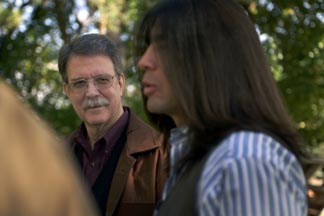Cross-border team to help Mexican farmers better manage their livestock
By Krishna Ramanujan

A multidisciplinary team of Cornell University scientists is working with colleagues south of the border to help livestock farmers in some of the poorest parts of Mexico raise production of cattle, sheep and goats despite limited resources.
The so-called U.S.-Mexico Training, Internships, Exchanges and Scholarships (TIES) program, which began in June 2004, addresses livestock issues in the state of Veracruz and the Yucatan Peninsula in southern Mexico.
The TIES program partners Cornell with researchers from the Autonomous University of Yucatan (Universidad Autónoma de Yucatán, or UADY), the University of Veracruz (Universidad Veracruzana) and the Mexican agriculture department, Instituto Nacional de Investigaciones Forestales, Agrícolas y Pecuarias, or INIFAP. This semester, two professors and two doctoral students from UADY, a professor from the University of Veracruz and a researcher from INIFAP are visiting Cornell.
The researchers are focusing on nutrition and land management so that farmers can use the resources available -- including native trees, legumes and grasses that grow on their land, along with supplements -- to feed their animals the most nutritionally optimal diet. In this way, the farmers can produce more meat or milk and make farming more viable economically. The researchers also are developing an academic agenda for the participating institutions in which Mexican and Cornell students can conduct research to provide specialized livestock nutrition information for farmers.
"We are taking a holistic integrated view of farming systems so we can make recommendations to farmers on how they can achieve their objectives," said Robert Blake, professor of animal science at Cornell, who is leading the university's involvement in the program.
Cornell will create four joint courses with UADY, as well as design an information clearinghouse on the Web. One of the biggest challenges for students in lesser-developed nations is access to information, so the Web site will include short courses and over 1,000 pages of literature in Spanish on such topics as how to manage forage areas, the nutritional value of local plants and how to use those plants to feed livestock.
"We realized we were not having the impact we thought we were having," said Guillermo Ríos, a visiting professor and veterinarian from UADY's animal nutrition department and co-director of the project. He conducted surveys with sheep and cattle farmers in the Yucatan to identify their issues and needs. "So now we are rethinking how we can change our education system to better help the producers. TIES is going to have a tremendous impact on our education and research system."
The Yucatan Peninsula is made up of flat limestone rock and lacks lakes, rivers and major forests. It remains one of the poorest regions of Mexico, relying largely on an economy of animal agriculture after its world-leading rope fiber industry collapsed with the rise of synthetic fibers. By contrast, farther up the Gulf Coast, Veracruz has more rain, mountains, diverse vegetation and is the number one beef-producing state in the nation.
While the farmers have a great deal of empirical knowledge, researchers hope to provide information to them on how to best use natural and cultivated vegetation, increase herd productivity and use strategies for mixing and managing different animals and crops.
Juan Magaña, a visiting professor and animal breeder from UADY, is developing courses and research projects on how genetics and breeding can increase cattle productivity and net economic returns. Magaña seeks to collect breed information from commercial cattle farms to help identify, for example, breeds that are best suited to different parts and climates of Mexico. All Mexican visitors, including Magaña and Ríos, attended a course in system dynamics modeling taught by Charles Nicholson, a TIES collaborator and researcher in Cornell's Department of Applied Economics and Management, that can be used to evaluate how farming systems behave over the long term.
The Cornell-UADY TIES program is one of 45 projects funded by USAID-Mexico through a grant administered by the Association Liaison Office for University Cooperation in Development in Washington, D.C., to foster alliances between U.S. universities and Mexico.
Media Contact
Get Cornell news delivered right to your inbox.
Subscribe